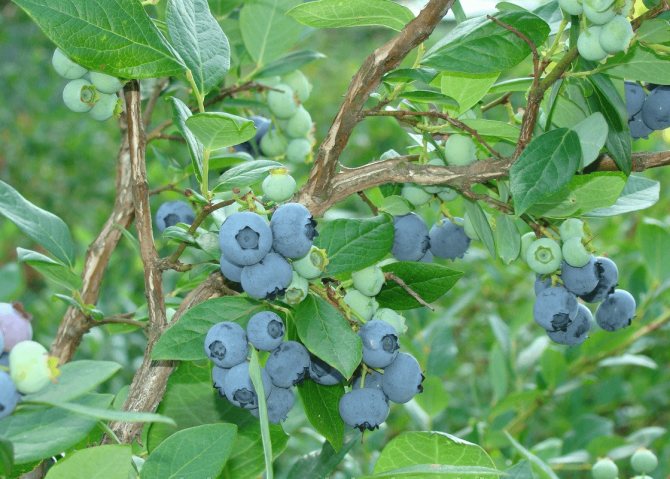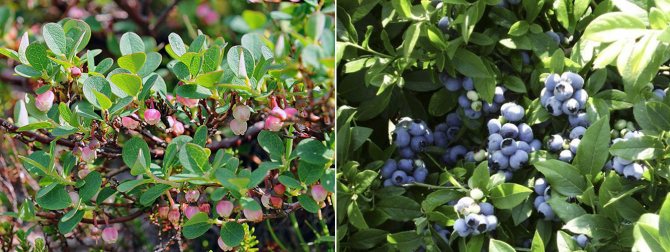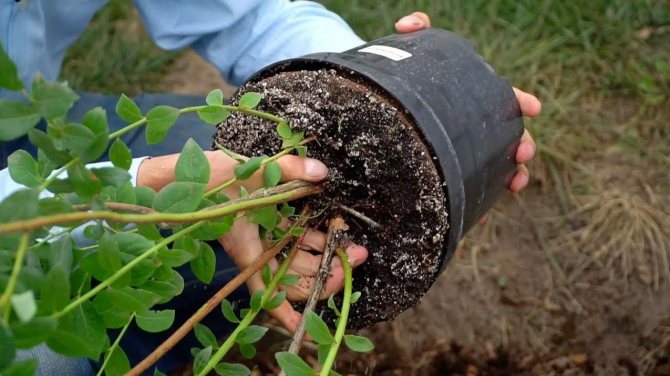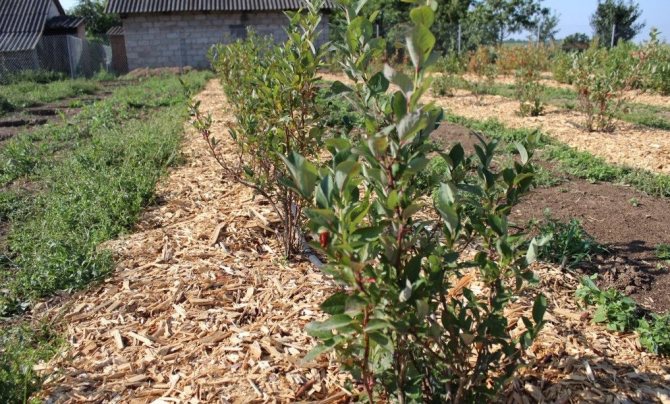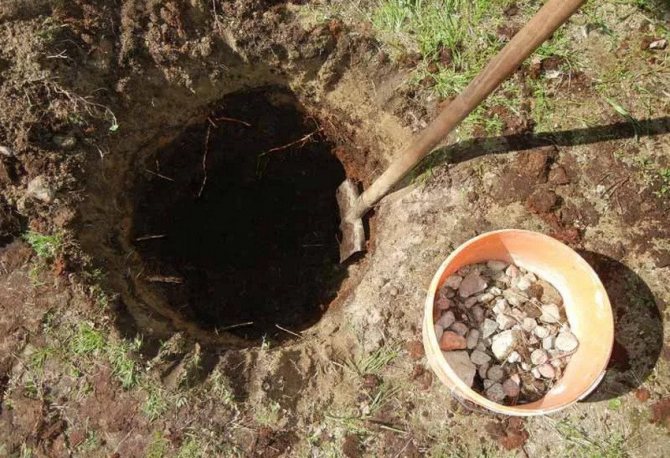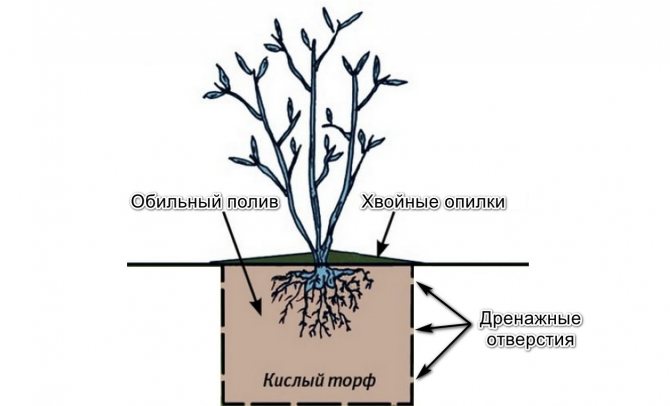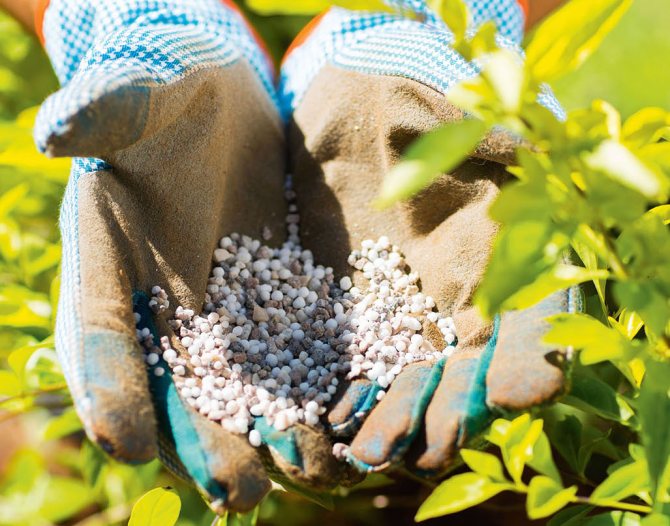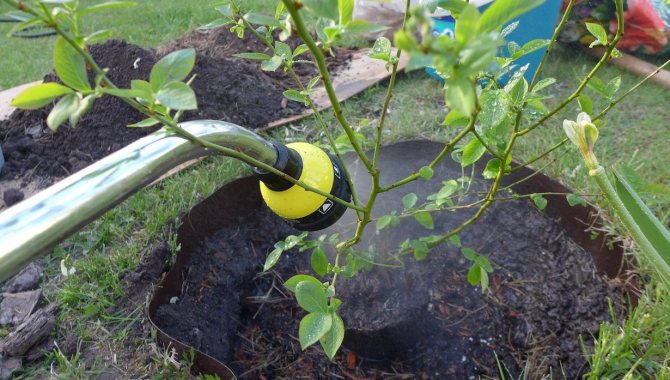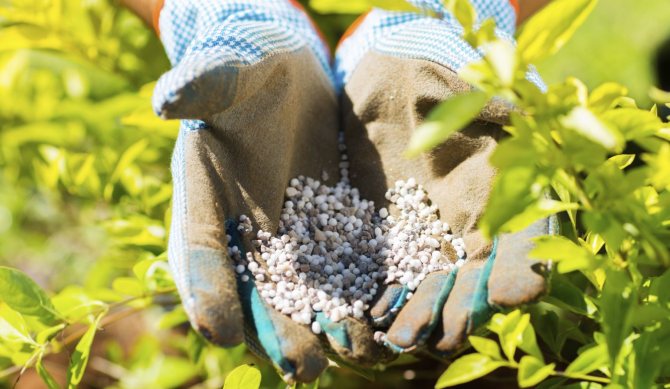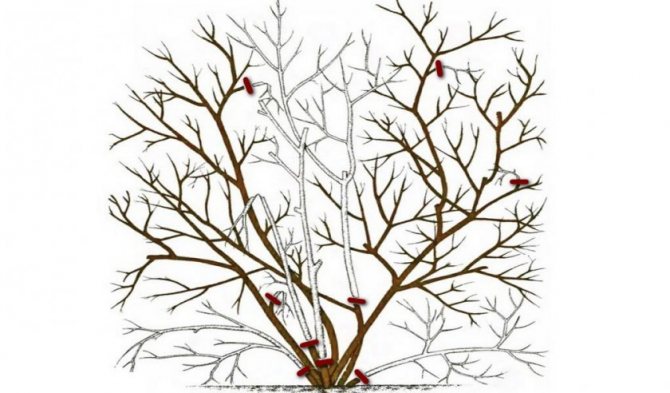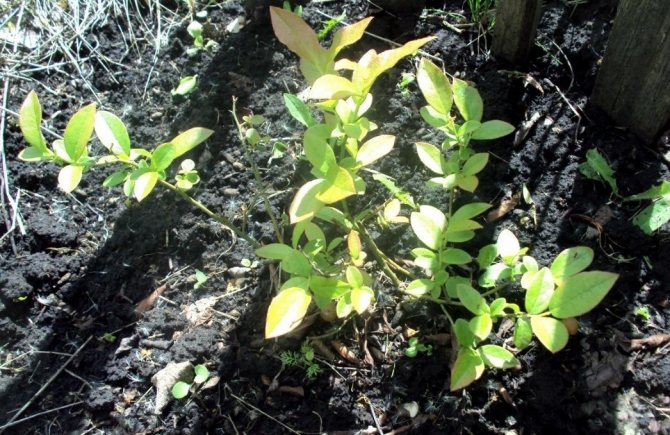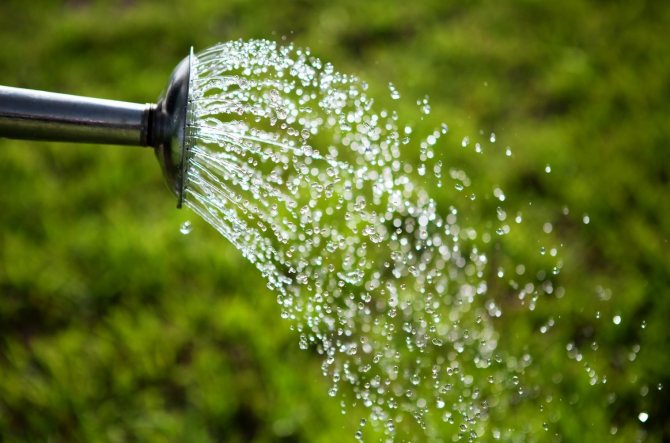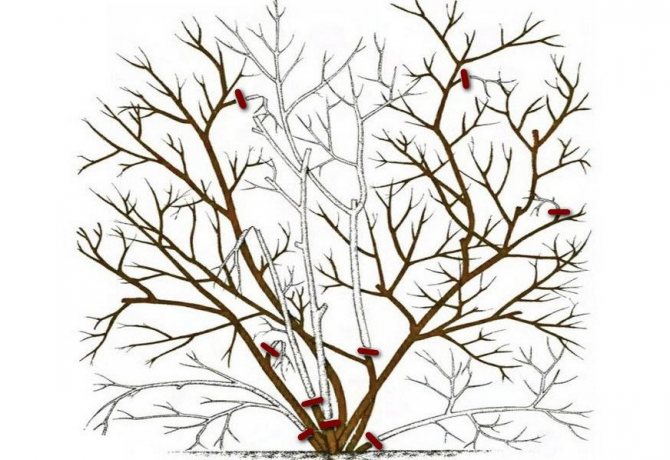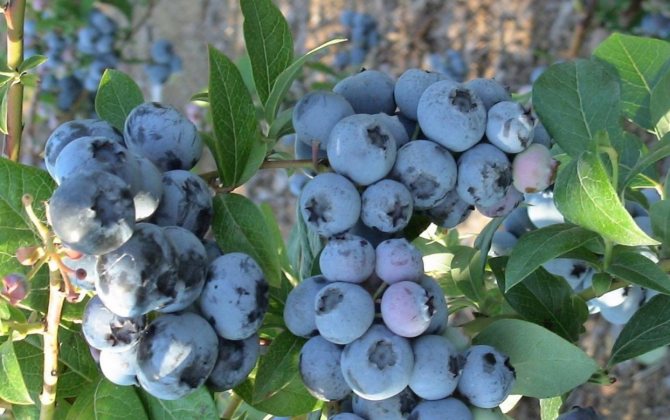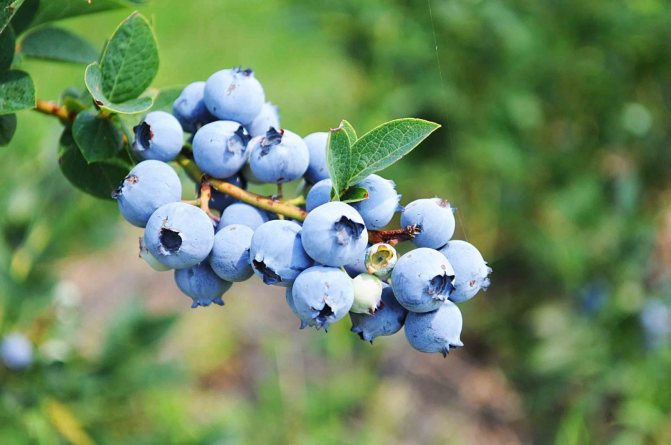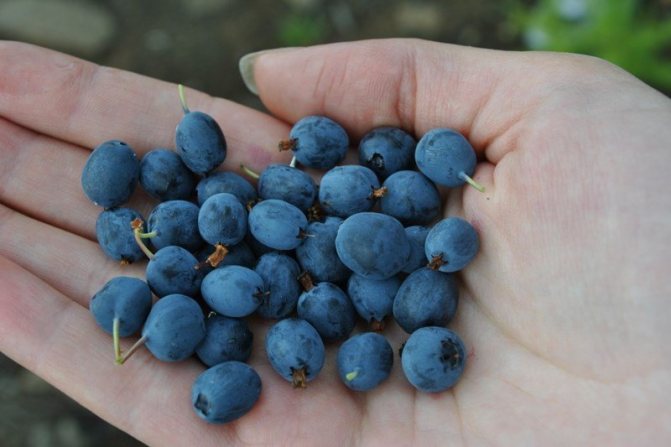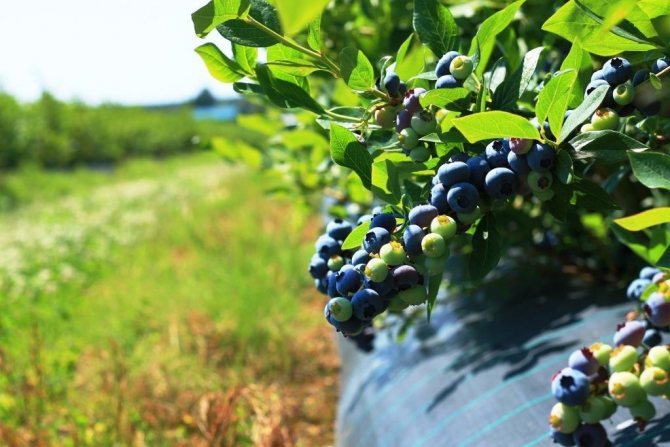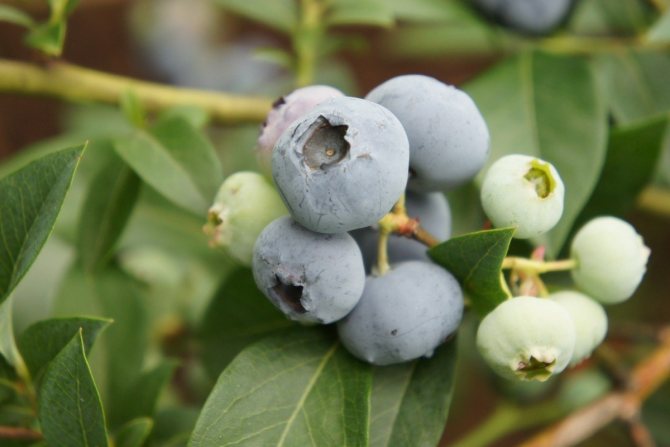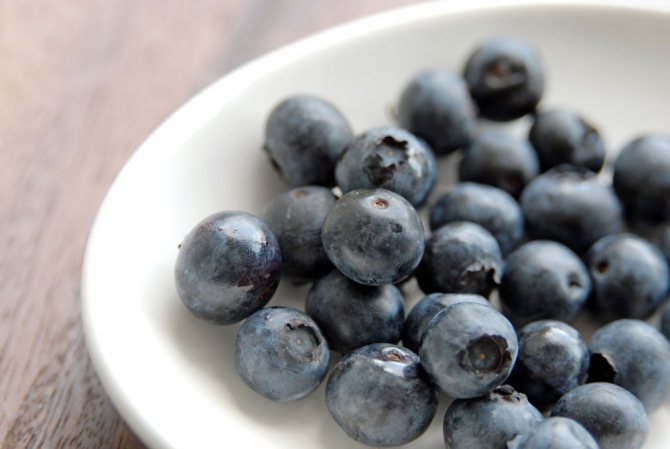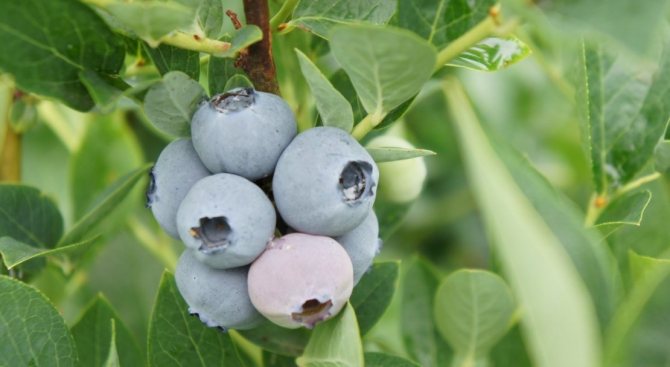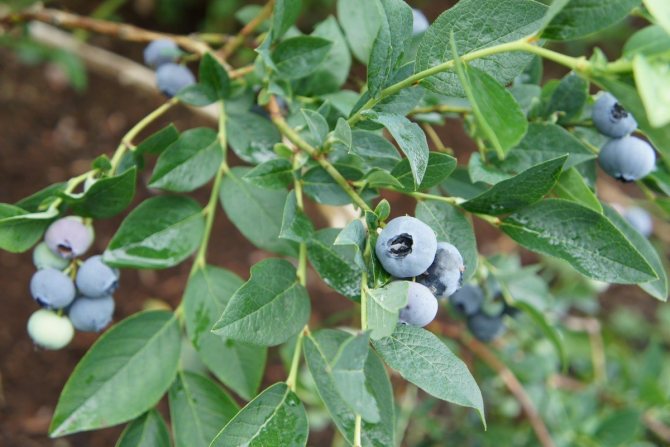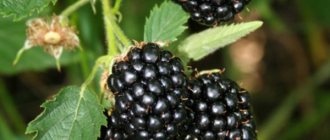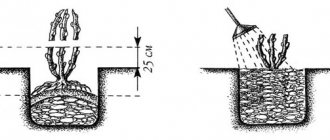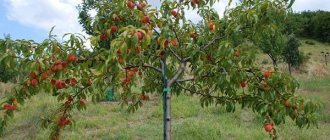Category: Growing Plants
Blueberry is a shrub up to 150 cm high. It belongs to the heather family, which is characterized by long rhizomes uniting several plants at once. This explains the speed and density of growth of these shrubs. Blueberries, planting and caring for which in the Moscow region are not difficult, have been successfully cultivated by summer residents for two decades. Let's try and we are with you?
- 5 best varieties of garden blueberries for the Moscow region
Bluecrop
- Early Blue (Earley Blue)
- Patriot
- Spartan
- Toro
- Choosing and preparing a place for growing
- Watering
- Seed propagation
Distribution and growing conditions
The shrub can be found almost throughout Eurasia, North America, northern Japan, Iceland, etc. Wild blueberries are widespread in places far from industrial enterprises and large cities.
Blueberry bush
The plant chooses swampy soil, peaty, acidic soil, coolness, moderate humidity. It lives in a variety of places: mixed forest, swamps, peat bogs, mountains, tundra, forest-tundra. Blueberries, like blueberries, rarely grow in one bush, they usually settle in large groups. Many residents of villages located in Siberia, the Urals, the Far East know the places where berries like a carpet cover huge meadows or the banks of small rivers and lakes.
Interesting! It is noteworthy that blueberries are one of the few berries that can grow normally where there is practically no soil. For example, in mountainous areas, on bumps in a swamp, on mosses in permafrost, etc.
If we talk about garden culture, then it can grow almost anywhere throughout the Earth. Cultivated blueberries are unpretentious. She is satisfied with the short summer, lingering cold weather, rains, heat. However, not all crop varieties are suitable for different territories.
What kind of blueberry is better to plant in the suburbs
Garden blueberries: planting and care
Garden blueberry varieties for the Moscow region are early, medium-early tall varieties. Their specificity is frost resistance, decent harvests. It is best to buy several varieties for the site at once. This way they will be able to pollinate better. This will have a positive effect on the taste of the berries and increase the yield.
Garden blueberry
Important! Nutritionists advise using blueberries for those who want to lose those extra pounds. This is a dietary product. Thanks to him, metabolic processes are enhanced in the body. In addition, berries help with problems with the digestive tract or cardiovascular system, strengthen vision.
The best blueberry varieties for the Moscow region:
- Earley Blue;
- Patriot;
- Spartan;
- Toro;
- Bluecrop.
Earley Blue
Early Blue is the earliest variety. The crop can be removed in July. Tall - height up to 1.9 meters. Fruits are large, diameter - 1.8 cm. Weight - 1.5-2 g. The color is deep blue.On the bush, the berries are formed in clusters of several dozen. Even after full maturation, they do not crumble. The yield is high - 7 kg per bush. In winter, it does not freeze at -30 ... -35 degrees.
Earliest Blueberry - the earliest variety
Patriot
A very beautiful shrub. This variety is often used to decorate the infield. In spring, the leaves are brick-colored, in summer they are emerald. Tall - erect bush stretches up to 1.7-1.9 m. Patriot medium early. The blue round berries, covered with a thick bloom, are harvested at the end of July. They are large - about 2-2.2 cm in diameter. Patriot tall blueberries are among the best varieties for the Moscow region for a reason. It tolerates severe winters down to -40, not particularly demanding on the soil, high-yielding, self-fertile. Summer residents remove 8 kg of fruit from the bush. Begins to bear fruit from 5 years after transplantation to a permanent place.
Spartan
Medium early variety. Harvesting begins from the 20th of July. Tall - bushes stretch up to 2 meters. The description of the culture contains information about winter hardiness. Withstands a drop in temperature to -30 degrees. Spartan blueberries like the climate near Moscow. Even in cool summers, it produces 6-7 kg of berries per bush. The berries are strong, 1.6-1.8 cm in diameter, cornflower blue. May fall off after ripening. A dacha with such a culture will be transformed. The shrub is beautiful, neat. In spring, the small leaves take on a brick color. During the summer months, they change and turn dark green.
Spartan blueberries
Toro
The variety has an average ripening period. They acquire a deep, bright blue color in August. The ripening period and characteristics of Toro are similar to Bluecrop. Deep blue berries, 2.2-2.5 in diameter. The branches bend under the weight of the blue bunches. Toro bush, like Bluecrop, can be grown up to 2 meters. The variety is fruitful - one bush yields 7-9 kg of high-quality berries. They don't fall off. The fruits ripen together.
Bluecrop
The Bluecrop variety vaguely resembles grapes. Bulky bushes reach 2 meters. Large berries ripen in clusters on the branches. Diameter - about 2 cm. Weight - 2-2.5 g. Color blue. There is a light bloom. The first harvest of Bluecrop gives 3 years after planting. Frost-resistant - survives winters with 35-degree frosts well. Has a strong immunity to common diseases. Ripening period is average. The berries turn blue in August. Annually, you can get up to 9 kg of fruit from one bush.
Bluecrop variety
What varieties are suitable for planting in the Moscow region
The Moscow region is located in a temperate climatic zone, so it is better to plant shrubs that have berries in the middle of summer. Breeders advise growing the following types of shrubs in the Moscow Region:
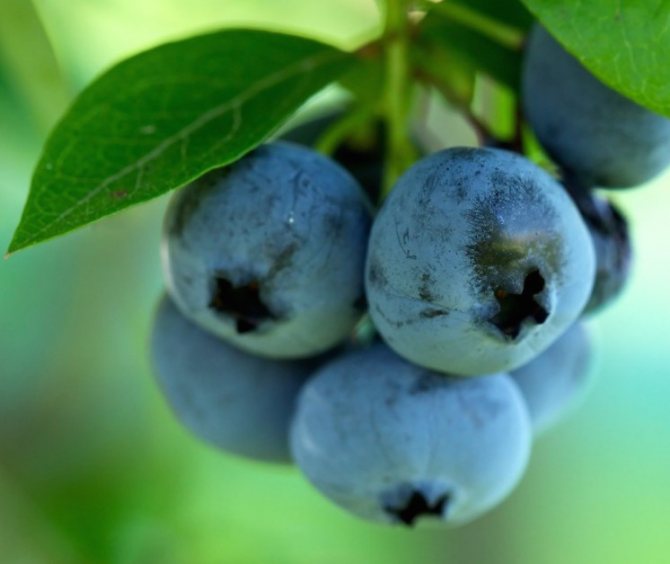
1. One of the most popular varieties is Bluecrop variety... It gives a good harvest of fruits, even if you do not care for the shrub. In addition, the variety does not disappear at low temperatures. Bushes are well resistant to diseases and pests. The fruits are large and sweet enough.
2. Many gardeners grow grade Patriot... Fruiting begins at the end of June. The plant does not freeze, and the berries can be stored well, while maintaining excellent taste. The variety is highly resistant to disease. You can make jam from berries, make jams. It is recommended to cover the shrubbery for the winter, as it may freeze out in the absence of sufficient snow cover.
3. Matters early Spartan variety... Each plant produces 6 to 8 large and tasty berries. The shrub withstands dry and cold weather conditions well. This does not affect the appearance of the plant in any way. In winter, the variety can freeze out, therefore it needs to be covered with spruce branches or foil material.


4. The high-yielding variety is Toro... The harvest ripens in late July - early August.At the same time, flowers and berries can be seen on the bush. Withstands negative temperatures without freezing. Also, the variety is not susceptible to various diseases. To preserve fruit formation, it is recommended to prune the crop every year.
Blueberry is a fairly unpretentious plant. If you take care of it regularly, then the shrub can respond to the care with a large harvest of tasty and sweet fruits.
Features of the berry


On the personal plots of good owners, you can see a variety of fruit and berry plants. Let's give a brief description of garden blueberries. The tall variety of culture is a deciduous shrub, the height of which reaches 1.2-2.5 meters. Garden blueberry shoots can be erect or spreading, depending on the variety chosen.
The leaves of the plant are smooth, oval in shape and rich green color. Their length ranges from 4 to 8 cm. In autumn, the leaves acquire a red-crimson hue.
Garden blueberry blooms in late May - early June. At the same time, pink or white flowers are collected in racemose inflorescences and have a weak pleasant aroma.
Fruit ripening occurs at the end of July - mid-August. The shade of the berries can be blue or inky with a bluish bloom on the peel. The size of the fruit is 10-20 mm, depending on the variety of garden blueberries and the care taken. Fruit ripening occurs gradually, so they are harvested in stages. Productivity from 1 bush reaches 3-7 kg. Ripe fruits can hang on the branches for about 2 weeks without losing their taste and marketability.
The beginning of the growing season of garden blueberries begins as soon as the air temperature rises above 0 degrees, which occurs in mid-April. The first harvest of fruits can be harvested 3 years after planting in a permanent place. The maximum yield indicator occurs by 8-10 years. The life potential of the bush is 30 years. The stability and quality of the harvest depends on the correct pruning of the blueberry bushes. Therefore, this procedure is mandatory when growing this crop.
Perennial shoots of the corymbus berry can withstand frosts down to -35 degrees, and the buds and flowers can withstand temperatures as low as -6 degrees.
Blueberries prefer to grow in acidic soils (pH 3.8 - 4.8). At the same time, the plant does not tolerate drying out of the roots and stagnation of moisture.
Reproduction methods
Blueberries are propagated in three ways:
- seeds;
- cuttings;
- layering.
Seed propagation
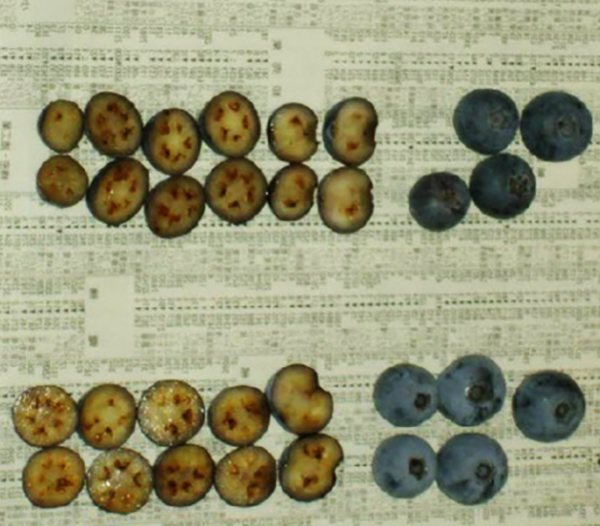

It is not easy to obtain blueberry seeds, let alone grow bushes from them!
The hardest way. It is optimal for nurseries and, if necessary, obtaining a rare variety. Gardeners rarely use the method of growing from seeds, but it does not hurt to know about it.
Stages of growing blueberries from seeds:
- Choose a ripe large berry without signs of rot and disease.
- Dry, remove the seeds. They are stored until spring at temperatures from 0 ° C to + 5 ° C.
- They are planted in April in warmed-up soil to a depth of 15 mm.
- Watering.
- Cover with a layer of mulch.
- Water regularly throughout the season, maintaining a moderate soil moisture.
Starting from the second year, the fertilizing required for garden blueberries is carried out.
Propagation by cuttings
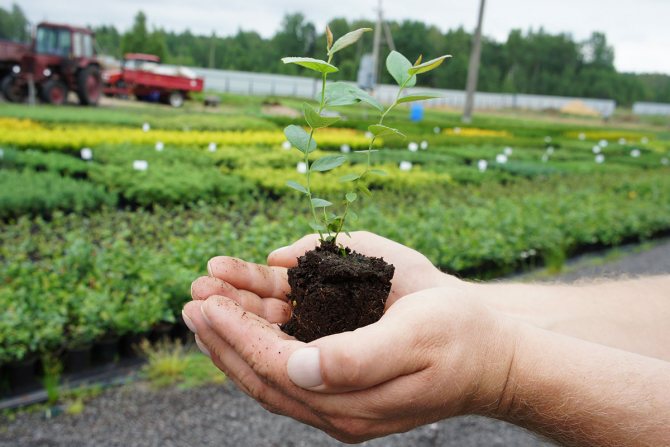

Cuttings are the most popular and easiest way to reproduce.
Blueberries are propagated by green and lignified cuttings. The only difference is in the method of obtaining the planting material. All other stages of growing are the same.
Green cuttings are harvested in mid-summer (from late June to late July) from the shoots of the current year.
- Abruptly cut or cut the branch downward so that part of last year's wood (heel) remains.
- All leaves are removed from the lower part of the cutting.
- For a day, they are immersed in Kornevin's solution.
- Planted in a greenhouse or greenhouse.
- For 1.5 months, they are regularly watered, preventing the soil from drying out.
- In the last days of August, they are planted in a permanent place.
- At the end of October, they are covered with a layer of peat or sawdust. Spandbond is laid on top.
- In the spring, the insulation layer is removed. The plant is not fed.
Freshened cuttings are harvested from December to March. Annual strong shoots are used. They are cut into pieces 12-15 cm long, each with 3-4 buds. Tied in a bunch and stored until spring in the refrigerator, cellar or snowdrift. In March, they are transferred to warmth for acclimatization. One day before planting, it is immersed in Kornevin's solution. As in the case of green cuttings, they are planted in a greenhouse or greenhouse.
Reproduction by layering
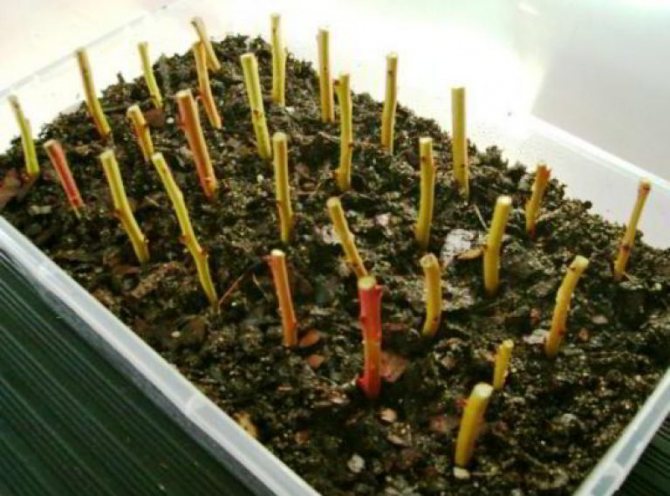

Reproduction by blackberries is not advisable for all types of garden blueberries.
This method is optimal for tall garden blueberry varieties. It is quite simple and popular. Is as follows:
- the lower branch of the bush is bent to the ground;
- if necessary, fix it with a wire bracket;
- sprinkle with a layer of sawdust.
After 2-3 years, a sufficiently developed root system is formed in this place. The branch is carefully separated from the mother bush and transplanted to the place chosen for it.
Landing dates
Actinidia: planting and care in the suburbs
It is allowed to plant a crop before winter or during the spring months. Planting blueberries in the spring in the Moscow region is carried out in April, as soon as the snow melts. At this time, the earth had already begun to warm up, and the sap in the trees had not yet gone. According to reviews, it is this period that is most favorable for planting a plant in open ground. Over the summer, the seedling will gain strength, take root in a new place.
If landing is chosen in the fall, then you need to pick up a fine day, preferably in September-October. It is necessary for a young plant to have 3-5 weeks in stock before frost. Otherwise, the blueberries will not take root.
Late
Representatives of a late ripening period bear fruit starting in mid-August.
Gardeners of the Moscow Region choose the following varieties:
- Bonus... Bred in 1978 in Michigan. Bushes are tall and spreading. They grow in a diameter of 1.1-1.3 m. The length of the shoots is 1.5 m. The branches are strong, brown in color. The leaves are elliptical, the plate is smooth, without pubescence. 7 pinkish flowers are collected in the brush. Berries are formed from them, on the blue strong skin of which there is a white bloom. The pulp is green, very juicy, tasty. After contact of juice or berries on skin or light-colored clothing, stubborn stains do not remain. The bushes consistently bear up to 8 kg of fruit. The variety is frost-resistant.
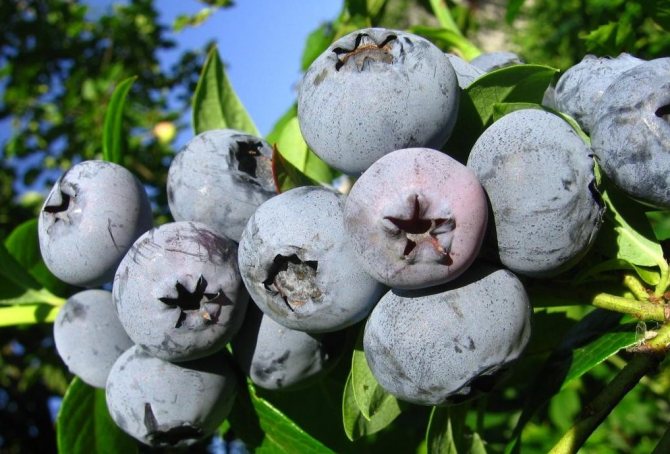

- Herbert... The bushes are strong, 2.2 m high. The branches are widely spread. Heavy and loose fruit clusters are formed on them. Large-fruited variety: berry size - 20-22 mm. Ripe, sweet and sour fruits do not crumble, the skin remains intact. Fruiting well - 6-9 kg per plant. Frost resistant, immune to pests and diseases.
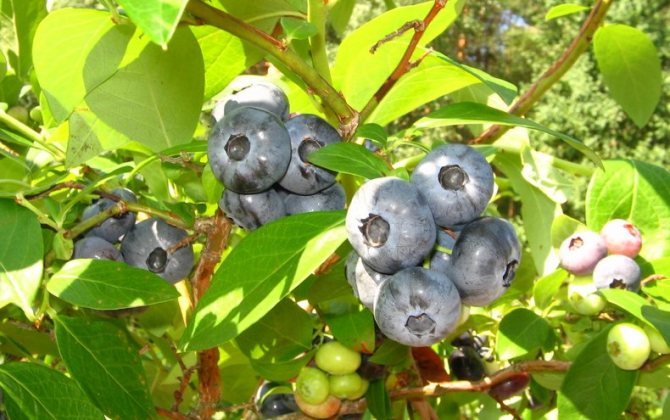

- Toro... The bushes grow up to 2 m in height, the shoots are strong, erect. Rounded emerald flower leaves. Large-fruited variety, produces berries with a diameter of 16–20 mm. The fruits are fragrant, sweet and sour. The berries do not crumble or crack after they ripen. The yield is good - 6–8 kg of ripe fruits per plant.
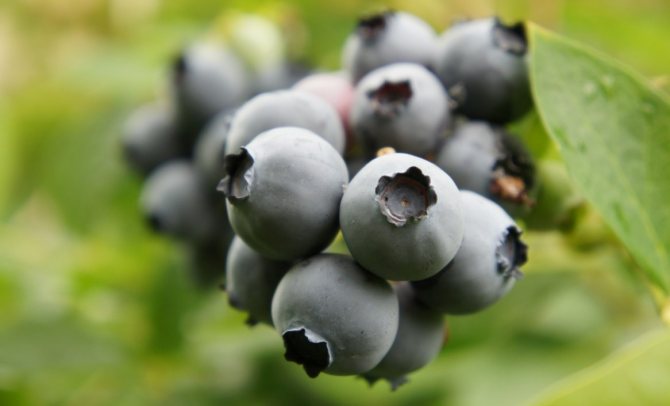

The above varieties are “reliable” and undemanding in terms of care. In a temperate climate, the Moscow region is developing well.
Planting garden blueberries in spring and autumn
The success of the landing depends, first of all, on the correct location. Where to plant this plant? Choose an area with good light and wind protection for blueberries.
Many gardeners mistakenly believe that since a wild berry grows in swamps, then in the garden for the plant, you need to choose the wettest and most shaded place, for example, under a tree. But in such conditions, if home blueberries do not die, then they will definitely not give a good harvest.
Be sure to check the acidity level of the soil. The plant requires an acidic soil with a pH of 3.5-4.5 ... If your soil is inadequate, it can be acidified. Colloidal sulfur or battery electrolyte (sulfuric acid only) is suitable for this. 1 ml of electrolyte diluted in 1 liter of water lowers soil pH by 2 points.
Another important point - the site should be rested , that is, for the past several years, nothing should have been grown on it.
Both spring and autumn are suitable for planting. But spring planting is preferable , as it allows the plant to grow strong enough for the winter.
When planting blueberries in the spring, you need to have time to do this before the buds swell. For the Moscow region, this is mid-April. It is better to buy a seedling in a pot, its root system will be more viable. Place the pot in a container of water for 30 minutes before planting. , then take out the young plant, straighten the roots and carefully clean them from the ground.


Planting garden blueberries
The landing procedure itself is as follows:
- Dig a hole 50 cm deep ... When planting several plants at once, it is necessary to make a distance of 50 cm between the holes for undersized varieties and 1 meter for tall ones.
- Loosen the bottom of the hole and put the peat bog there, mixed with sawdust and needles. Then add sulfur in an amount of 50 g and mix everything thoroughly again. This will create ideal acidic conditions in which blueberries will thrive.
- Place a seedling in the hole , straighten its roots and cover with soil.
- Water and mulch liberally using coniferous sawdust.
In the future, the seedlings need watering every 2 weeks. In this case, the water must be enriched with citric acid or apple cider vinegar (20 g per 5 liters of water).
If you nevertheless decide to plant the plant in the fall, then you need to do this a month before the stable cold weather, that is, during October. Autumn planting technology includes all the same actions , only at the end, pruning of a one-year-old seedling is still required. Remove weak branches with pruning shears, and shorten the strong ones in half.
If you have purchased a 2-year-old seedling, it does not need to be pruned after planting.
If all the conditions are met, blueberries will grow rapidly and next year we will delight you with the first small harvest. And in order for the yield to reach a high level in the future, the plant must be provided with proper care.
Category: "Questions and Answers"
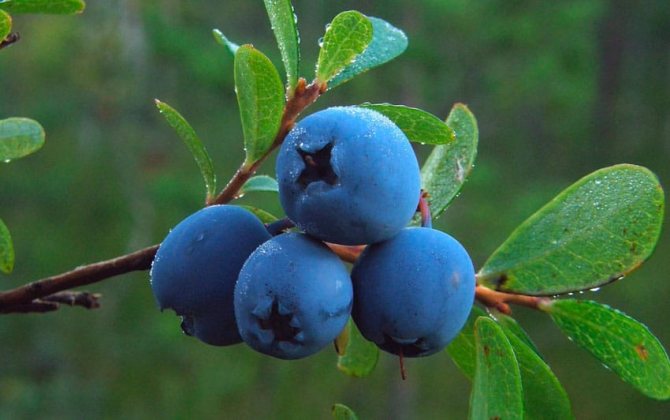

Question number 1. What varieties of blueberries to plant in a dacha near Moscow, if the plot is small?
In small areas, it is better to grow compact, low and medium-sized hybrids:
- Chippewa - 0.8 - 1 m;
- Patriot - 1 - 1.4 m;
- Bluehold - 1 - 1.2 m;
- Northland - 1 - 1.2 m;
- Northbloo - 0.6 - 0.8 m;
- Northcantry -0.7 - 0.9 m.
Question number 2. What varieties of blueberries can be grown in a greenhouse near Moscow?
It is better to give preference to domestic undersized hybrids:
- "Blue Scattering";
- "Wonderful";
- "Graceful";
- Iksinskaya;
- "Taiga Beauty";
- Shegarskaya;
- "Yurkovskaya".
Question number 3. Can all blueberry varieties be frozen?
Unfortunately no. After harvest, firm, undamaged fruits can be harvested. Blueberries quickly lose their firmness. The varieties keep their shape well: "Bonus", "Elizabeth", "Northland", "Jersey", "Rankokas".
Question number 4. I have two varieties of blueberries, early Erliblu and medium Bonus. The one that ripened earlier was sour, the one that was sweet in August. What determines the taste of berries?
First, the weather conditions. Perhaps during fruiting it was cool and little sun. Secondly, on the timing of the harvest. If berries are picked ahead of time, they do not have time to gain a balanced supply of substances. True, it is not worth delaying the harvesting of fruits, otherwise the crop may end up on the ground.
Step-by-step landing instructions
Despite the fact that the culture is quite unpretentious, you need to take time to plant and complete all stages carefully, according to step-by-step instructions. If done correctly, blueberries will bear fruit for three to four decades. In the spring, planting is carried out according to the same principle as in the fall.
Planting a blueberry bush
A place
Honeysuckle: planting and care in the suburbs
The best place to plant a crop is sunny, without drafts. You can choose an area near the fence. You can not plant a plant in lowlands, where there is a high probability of moisture accumulation.
Note! Garden blueberries are difficult to please with their predecessors. Therefore, it is recommended to grow the crop in a place where nothing has grown for several years. It is allowed to plant in places where there were herbs, under which no organic fertilizers were applied.
The Moscow region, like the rest of the regions that are part of central Russia, has predominantly clay soil, which does not allow moisture to pass through well. And locking is not acceptable for blueberries. In order for blueberries to feel good, you can plant them in a high bed. The box is made of boards or logs. Its dimensions are: width - about 70 cm, depth - 50-60 cm. A hole is being dug. A box fits into it.
A high bed, in turn, is filled with a specially prepared substrate. Due to the fact that the plant loves sour, loose soil, drainage, then it is necessary to prepare the soil mixture from:
- ü sour red high-moor peat;
- ü black lowland peat;
- ü rotted sawdust;
- ü sand;
- ü needles;
- ü compost from the bark of coniferous plants;
- ü You can add 40-50 g of sulfur (to oxidize the mixture).
Fundamental rules
If several tall blueberry varieties are planted at the same time, then the distance between them should be at least 100-130 cm.
When digging a hole, the land owner must note the type of land. If peat or sandy soil predominates, then the depth of the planting pit is 50 cm, it should be about a meter wide. Drainage from stones can be placed on the bottom. If the land on the site consists of the same amount of clay and sand, then a depth of 35 cm is sufficient. If clay lumps prevail, then you can dig a hole that is not deep - on a shovel's bayonet or a little deeper. However, it will have to be expanded further - up to 1.5 meters. Thanks to this scheme, the likelihood of stagnation of water that the culture cannot tolerate will be minimal.
Preparing a place for blueberries
Seedlings are bought in proven nurseries. They must be healthy, strong, without damage. Shoot length - from 55 cm. Age - 2.3 years. The root system must be closed. It is better to stop the choice on a plant in a container.
Interesting! Before planting, the pit is spilled with warm water with the addition of a growth stimulant. Thanks to this procedure, it will be possible to grow a strong, healthy plant.
The seedling is placed in a bucket of water a few hours before planting in a permanent place.
All dry and broken branches are removed from the plant.
Planting stages
- In a high bed filled with a substrate, a depression is made. Water is poured;
- The seedling is removed from a bucket of water. The earth that protects the roots is wet, and therefore the roots of the plant are easy to stir up, straighten so that they grow in the ground in different directions;
- Next, the plant is placed in the soil mixture so that the root collar is at ground level;
- The root system of the seedling is sprinkled with a substrate;
- The blueberry bed is completely covered with mulch. Straw or dried grass and bark compost are suitable for this. The width of the layer is 5-7 cm.
Blueberry planting stages
How to propagate a plant by cuttings
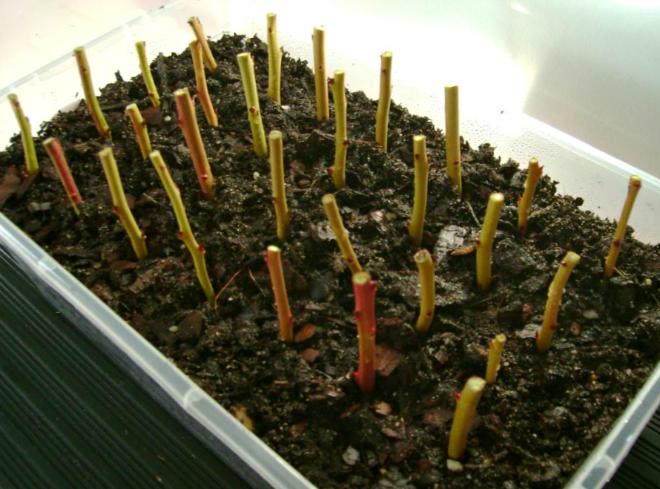

Planted blueberry cuttings
The easiest way to propagate a culture is by grafting. This can be done at home. For this, small branches are cut. Their size varies from 12 to 15 centimeters. Each stalk should have several buds.Harvesting of green branches is carried out in the first days of July. The upper part of the branches grown in the current season are suitable for the procedure.
If the branches are lignified, then they are harvested during the winter months. Shoots that appeared in the past year are suitable for cuttings. After cutting the twigs, leave the wood on top. The stalk from the bottom is carefully freed from foliage.
A special preparation is poured into the container, which accelerates the rooting process, and mixed with water. Then they put all the cuttings there and stand for a day. For disinfection, cuttings must be put in a weak solution of potassium permanganate for 2-3 hours. They are subsequently recommended to be grown in greenhouse or greenhouse conditions. Planting works are carried out from February to March. Then, for 6-7 weeks, the planting site is regularly watered, which reduces the risk of drying out the soil.
In the last days of summer, young seedlings are transferred to a place of permanent growth. In mid-autumn, the ground around the plants is covered with a layer of mulch. For the winter, the landing site can be covered with spruce branches or special material. That helps delicate plants to survive harsh weather conditions. When the snow melts, the protection is removed. The plantings are carefully examined. If there are those that have not survived the winter period, they should be removed. Then the shrub is thoroughly watered. 3-5 liters of water are poured under each plant. Subsequently, the landing site is mulched again. It is not recommended to feed the plantings at this time.
Pruning a young seedling
Before the start of stable fruiting, it is necessary to form a strong skeleton of the crown. If you leave the bush unattended for 1-2 years, then the number of small shoots will increase, which will thicken the bush, and flower buds will be laid on the tops of the main shoots.
This will promote the formation of the first berries. At the same time, a thickened blueberry bush will not be able to give a full harvest, since its forces will begin to be randomly distributed into small unnecessary shoots. Against this background, the plant weakens, the likelihood of its defeat by fungal diseases increases. Therefore, it is worth sacrificing the first berries by removing the apical flower shoots to form a strong bush with productive shoots.
Here are some tips for beginners on pruning blueberries in the fall of the second year after planting:
- Remove all small growth from the root.
- Select 3-4 shoots. They should be the strongest in appearance and directed upwards. These shoots will form the skeleton of the bush.
- Cut off all vertical branches growing on the shoots left below 30 cm from the soil surface.
- Trim off the tops where the flower buds have formed.
As a result, this procedure will postpone the first fruiting for some time, but it will make it possible to form a strong bush, which will consist only of productive and strong branches.
Preparing for winter
In general, tall varieties of culture perfectly tolerate frosts without shelter. But if the variety is medium-sized, then care should be taken to preserve it, since the winters near Moscow can be quite harsh for the plant.
When preparing for wintering the branches of the plant are bent to the ground and covered with a dense layer of spruce branches... You can use burlap. To do this, the branches are first wrapped in burlap, tied with a rope, then bent to the soil surface and fixed. During the snowfall period, you can sketch on top of a layer of light snow.
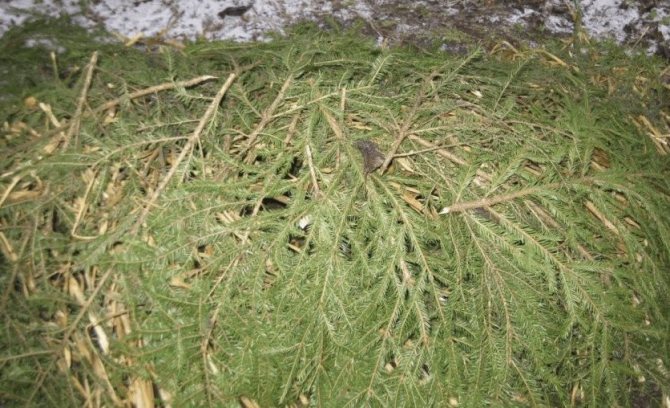

Culture care
If we talk about a seedling, then caring for blueberries in the spring in the Moscow region consists of abundant watering several times a week. But mature bushes should not be ignored either. In order for the shrub to give a bountiful harvest, not to get sick, it must be properly looked after.Basic care procedures: moistening the soil, mulching, weeding, loosening, fertilizing, acidifying the soil, pruning, pest control, preparing for winter. Agricultural technology is simple.
Moistening the soil
The blueberry bush loves moist soil. During the spring and summer months, the crop should be watered every 3-4 days. One plant will have to pour 15-20 liters of water. If the summer is dry, then the frequency of watering is increased. In the evening, the gardener can water the plant completely, pouring water over the shoots and leaves. Watering ends by September.
You can water the plant completely by pouring water on the shoots and leaves.
Mulching
Make sure that the area under the blueberry bushes is covered with mulch. Thanks to her, the minimum number of weeds will grow, the moisture will not quickly evaporate. You can cover the ground with hay, straw, sawdust, compost from the bark of coniferous trees. Mulch is renewed every few months. Its change takes place once a year - in the fall.
Weeding, loosening
It is recommended to perform these procedures once a month. The root system of blueberries is shallow. Loosening is carried out carefully using a hoe. At the same time, weeds are harvested.
Fertilization, soil acidification
The procedure is performed several times: after the snow has melted, after the bird cherry blossoms, and after the flowering of the blueberry itself. The crop is suitable for multicomponent complex complex fertilizers, for example, Lifdrip, Yara Vila, Florovit.
Important! You can not bring organic matter under the bushes of garden blueberries. This action will deacidify the soil.
Summer residents should monitor the acidity of the soil on which blueberries grow. Constant watering makes the soil less acidic, so it is acidified every year. The procedure takes place in April and August. For this, 20 ml of citric acid is diluted in a 10-liter sprinkler with water.
Pruning
Pruning is done three years after planting. It is necessary to remove branches after the snow melts and before the sap flow begins. Diseased branches, shoots bent to the ground, weak, broken, small and old are removed. Do not touch erect strong shoots. This will form a strong plant base.
Pruning branches
Fight against diseases, pests
Despite the fact that blueberries rarely get sick, they do not have complete immunity from pests and diseases. The gardener must recognize the disease in time and start fighting with drugs.
Gray rot
The garden blueberry loves moist soil, but cannot tolerate waterlogging. Excess moisture contributes to the development of gray rot. An effective means of control is Topsin-M fungicide.
Stem cancer
Symptoms of the disease are dark spots on the shoots that turn into ulcers. Chemicals are suitable for treatment: Euparen, Topsin-M.
Blueberry stem cancer
Fruit rot (moniliosis)
Certain signs of a fungal disease are yellowed upper parts of the shoots, drying of flowers. You can fight fruit rot with the help of the Hom preparation.
Among the pests on blueberries, the following can be found:
- ü leaf gall midge;
- ü aphid;
- ü shield;
- ü kidney mite.
To combat them, chemicals are used: Karate, Karbofos, Thunderstorm.
Pre-winter preparation
On a note! Garden blueberry is a frost-resistant plant. However, it is best to protect it from severe frosts. Pre-winter shrub preparation is to cover it. Spunbond, agrotex, lutrasil are suitable. You can tilt the bush to the ground and throw pine, spruce branches over it.
Nuances
- The culture should not be fed with preparations containing chlorine. The plant categorically does not accept it;
- It is impossible to wrap the bushes with foil for the winter. This will disrupt air exchange;
- You can acidify the soil not only with citric acid, but also with vinegar, sulfuric, oxalic acid;
- Particular attention should be paid to watering while pouring the fruit.
Disease and pest control
In general, garden blueberries are resistant to diseases and pests, but if not properly cared for, they can still fall prey to these negative factors (Figure 7).
As a rule, insecticide treatment is used to eliminate insects, but it is much better in the spring, after swelling of the buds, to carry out preventive spraying. The most common blueberry pests are kidney mites, aphids and flower beetles. To combat the first, the drug Nitrofen is used, Confidor and Bi-58 are excellent against aphids, and shrubs are sprayed with Fufanon to eliminate flower beetles.


Figure 7. The main diseases of the culture: 1 - stem cancer, 2 - moniliosis, 3 - gray rot, 4 - physalosporosis
Blueberry diseases are rare. Among them are:
- Stem cancer: at the initial stage, it appears as small red spots on the leaves and bark, which gradually grow and capture more and more healthy tissues. In order to prevent the spread of the disease, it is necessary to carry out sanitary pruning in a timely manner and carry out spring processing with Topsin or Fundazol.
- Moniliosis: outwardly manifests itself as frostbites. Unfortunately, there is no effective treatment for the disease, therefore, the damaged parts of the shrub must be removed, and the plant itself must be sprayed with Topaz for prevention.
- Gray rot: develops if blueberries are grown in an area with high humidity. Affected shrubs can be treated with Eurapen, but it is much more effective to prevent moisture accumulation at the roots by planting plants in areas with well-drained soil and adjusting the irrigation schedule.
- Physalosporosis: manifested by the formation of small red spots on young shoots. There is no cure for the disease, so all affected parts must be immediately cut off and burned.
You will find useful tips on choosing a blueberry variety for growing in the Moscow region in the video.
Consider blueberry varieties for the Moscow region
Bluecrop
Known to gardeners since the middle of the 20th century. The height of the bushes is 1.5-1.8 meters, the berries are 2 centimeters in diameter, weighing up to 1.4-1.9 grams, the skin is of medium density with strong pubescence. Ripens at the end of July (mid-season). A distinctive feature of the variety is fruiting on the shoots of the past and current year. The bushes are slightly spreading, the buds are light-colored in spring. Very frost-resistant variety, tolerates drought, disease is not affected.
Patriot
The variety was developed in America in the mid 70s of the last century. Early ripening. The crop can be harvested in the Moscow region in mid-July. The berries are oval, dull blue, up to 1.2-1.5 centimeters in diameter, the skin is dense. They tolerate storage and transportation well.
Northland
Bred in Michigan, in the middle of the 20th century, by crossing Berkeley (tall) and 19-H (hybrid of low-growing blueberries and Pioneer varieties). The bush is low or medium, reaches a height of 1.2 meters, spreading. In autumn, the foliage acquires red-purple hues, the variety is highly decorative. The berries are round, 1.6 centimeters in diameter, the skin is dense, light blue, with a bluish bloom, ripen in mid-July. Sweet taste, aroma peculiar to wild berries. The variety gives regular yields, but is not drought tolerant.
Northblue
Bred in the United States by crossing tall and narrow-leaved forms US-3, G-65 and Dwarf, has increased frost resistance, tolerates temperatures down to minus 35 degrees. The height of the bushes does not exceed one meter. The berries are large, with a small scar, the skin is dense. The juice contains an increased amount of anthocyanin, which has a rejuvenating and antioxidant effect. For annual abundant fruiting, the variety requires cultivation in well-sunlit places.
Jersey
Late ripening (mid-August), suitable for long storage and processing. Berries of medium size, balanced taste.The variety is a good pollinator for all of the above.
Earley Blue
The variety is of medium early ripening, the first harvest can be carried out in early July. The diameter of the berries is 1.5 centimeters, the brushes are conveniently located for picking from the branches. Withstands frosts down to minus 27 degrees.
Spartan
Variety with powerful erect shoots, up to 2 meters high. The berries are medium in size, round, with a pleasant sourness on the palate.
Toro
Bushes are powerful, reach a height of two meters, late ripening. Berries are harvested in the second and third decades of August. The variety is frost-resistant, is not affected by diseases and pests.
Bluegold
This popular blueberry variety is light blue with a dense, aromatic flesh. And the bushes themselves are lush and beautiful, so they will be a wonderful decoration for any garden. However, it should be borne in mind that spreading is at the same time a lack of bushes of this variety, because they require strong pruning.
Bluegold is an early variety. The fruits acquire a rich color at the beginning of summer and ripen amicably by mid-July. From one bush, from 4.5 kg of berries are harvested, even in not the most productive years.
This blueberry can withstand frosts down to -35 ° C, therefore it is suitable for growing in northern regions. The weak side of the variety is that its berries wilt quickly, mummify, especially if the summer is hot.
Bluegold berries crumble when overripe, so it is important to harvest on time!


